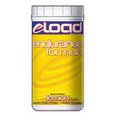Filter By:
Drinks
$54.99
The Science of e load ™
Taste
In the heat, especially when exercising, taste perception changes, when things that taste normal at rest suddenly seem overpowering, even nauseating (11,12). e load™ is formulated to reflect this fact. When mixed according to the instructions, e load™ actually tastes a little "dilute" from a flavor perspective than when sampled at rest, but has a full, refreshing flavor during exercise.
Additionally, with our "natural only" policy, e load™ contains only natural flavors, and nothing artificial.
Finally, e load™ has no syrupy, sticky taste, purposely being formulated with a 5.4% (54 grams per litre) carbohydrate concentration compared to a range of 6-8% (60-80 grams per litre) in most of our competitors. Again, in the heat, this is an important consideration in preventing nausea.
--------------------------------------------------------------------------------
Compare
Natural Flavors
Marginally dilute taste at rest; full taste during exercise
Not too syrupy during exercise; no "pasty" mouth feel
Absolutely nothing artificial!
--------------------------------------------------------------------------------
Electrolytes
Bottom Line
•The most important sweat electrolyte is sodium, with an average concentration of 800 mg/litre (39), and with an average as high as 1000-1100 mg/litre, especially in hotter, more humid environments (14, 40). Under-replacing sodium can lead to heat illnesses including dehydration, muscular cramping, headaches, gastrointestinal upset, nausea, fluid retention and hyponatremia.
•Potassium is the second most important electrolyte in sweat. Under-replacing potassium can substantially affect sodium balance, contributing to heat illnesses.
•Calcium, magnesium, zinc and choride are also important electrolytes found in sweat. Calcium and magnesium deficienies may contribute to muscular cramping.
•The sodium:potassium ratio in sweat is about 3-5:1 - your drink should reflect this.
•The calcium:magnesium ratio in sweat is about 2:1 - your drink should reflect this.
Introduction
Electrolytes (sodium, potassium, calcium, magnesium, zinc and chloride) are an incredibly important part of a sports drink for performance in the heat, and all are lost through sweating. Electrolytes are responsible for maintaining many functions in the human body, including normal muscle contraction, blood pressure, nerve conduction, heart rate and gastrointestinal motility, to name a few. They also play an important role in energy metabolism. Allowing electrolyte concentrations to fall below normal through the process of sweating can contribute to the many problems discussed in the "Heat Stress and Heat Illness" section, including muscular cramping (13). This is a crucial issue in managing heat stress; however, most sports drinks have minimal and/or incomplete concentrations of electrolytes, and do very little to counter the electrolyte depleting effects of sweating.
Average Amounts in Sweat
The sodium concentration in sweat averages 800 mg/litre (39), and may average as high as 1000-1100 mg/litre, especially in hotter, more humid environments (14, 40), and varies by diet, sweating rate, hydration, and degree of heat acclimation (39). Sweat glands reabsorb sodium, but the ability to reabsorb sweat sodium does not increase with the sweating rate; thus, at high sweating rates the concentration of sodium in sweat increases (17). The potassium concentration in sweat averages 195 mg/litre; that of calcium, 50 mg/litre; that of magnesium, 25 mg/litre, and that of zinc, a trace mineral, less than 1 mg/litre (45). Gender, maturation, and aging do not appear to affect sweat electrolyte concentrations markedly (39).
Compare this with most sports drinks, which typically have between 120-430 milligrams of sodium per liter, falling far short of the ideal. A higher sodium drink helps prevent heat cramps and other manifestations of heat illness, stimulates thirst, reduces urination, and enhances dextrose (glucose) absorption from the small intestine (4, 13).
Also, compare most sports drinks, which typically have between 80-115 milligrams of potassium per litre. Falling potassium levels can contribute to all of the heat illnesses, including cramping and hyponatremia (15, 16). Deficiencies in one or both of these important electrolytes can have detrimental effects on exercise performance, especially in the heat. In addition, the sweat sodium : potassium ratio in humans is between 3:1 and 5:1. We are amazed at how many formulas out there ignore this important physiological truth. Some drinks even have more potassium than sodium in them. This would be great if your sweat had more potassium than sodium in it, but this isn't the case.
Also, the calcium : magnesium ratio in sweat is about 2:1, and your drink should reflect this. Replacing these important electrolytes in these ratios is important in order to opt
Page 1 of 1

